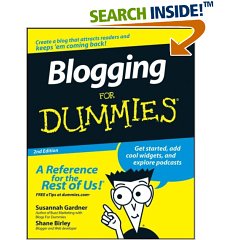|
Three key assumptions:
...You already know how to write.
...You want a new venue for your writing,
as well more visibility for your writing and writing-related
activities.
...You are interested in the blog as a new
literary genre / artform.
BEST
PRACTICES
#1. Start with clear intentions.
What do you want your blog to do for you? How much time are you
willing to spend blogging? What image do you want to project?
What kind of readers are you aiming to attract?
I started my blog, "Madam
Mayo," to help promote my anthology, Mexico:
A Traveler's Literary Companion, as well as my
other books, events, and workshops.
That said, I have continued to blog because I love exploring
the form. I now think of my blog as a kind of filter (read
about that here).
 #2. Open your mind to the many possibilities
of what your blog can be and do. #2. Open your mind to the many possibilities
of what your blog can be and do.
Be careful not to jump to conclusions about what a blog is or
is not. Guest-blogging
on "Madam Mayo," Tom Christensen (whose blog is "Right-reading")
wrote: "Just as there is no one way to write a novel,
so there is no one way to write a blog. I imagine Joyce's blog
would look a lot different from Proust's, or from Kafka's, or
from Celine's, and so on."
Be sure to have a look at my
list of top writer's blogs— you might be amazed at how
different they are from one another. Writers are forever telling
me, "I can't blog because I don't have time to post every
day." But why, pray tell, do you "have to" post
every day? Or, "I can't blog because I don't have time to
deal with all the comments." Who says you have to allow
comments?
With your blog, you make the rules.
#3. Provide content that is useful, interesting, charming,
or at least funny.
Because otherwise you will not have readers! This sounds
obvious, but for a large number of writers, alas... well, go
visit a few and see for yourself.... Writes
Tom Christensen (again on "Madam Mayo"), "you
have to have something original to offer. Some bloggers do succeed
as aggregators of content produced by others, but I think it
is more difficult to get by with that approach than it used to
be. Sure, many posts can consist of passing along items spotted
elsewhere, but unless you create some original content with a
unique point of view, it will be difficult for the blog to grow."
#4. Make it clear to a first-time
visitor who you are as a writer.
Your name, what you write, the link to your books and web page,
etc. This information can be contained in a link and/or the sidebar,
but make sure it's right up front.
#5. Offer brief posts, as
opposed to essay-like posts.
There are some notable
exceptions, but generally, the better blogs offer short posts
(a single sentence to a paragraph or two), that are rich with
quality links.
#6. Feature guest-bloggers.
A voice other than your own can liven up your blog. Tip:
Anyone who is actively promoting something (a new book, for example)
is usually game to offer a guest-blog post. I find they are most
likely to accept when this does not require more than a paragraph
of writing, and when I can offer them a specific date for their
guest-blog post. Madam
Mayo, for example, hosts guest-bloggers (generally) on Wednesdays
with a "5
link format."
#7. Offer lots of good links.
For example: if you mention a book, link to that book's page
on, say, amazon.com. If
you mention, say, Jane
Austen, be sure to offer a link to some
web page about her. I love to find lists of links. On my
own "Madam Mayo" blog, I offer, for example, Top
10 Books read in 2007; Top
5 Pug Videos on Youtube; 10
Tips for Getting the Most Out of Your Writing Workshop.
#8. Post on a regular schedule.
To attract repeat visitors, predictability is more important
than frequency. Though certainly, frequency helps. As noted on
the home page, "Madam Mayo" is "updated every
Monday and in-between more often than not. Guest-blog posts generally
on Wednesdays."
#9. Indulge in a few off-topic
obsessions.
This tip is from novelist
Leslie Pietrzyk,
whose blog is "Work
in Progress." Guest-blogging
on "Madam Mayo," she wrote, " I enjoy feeling
there's a person— complete with quirky taste— behind
the magic curtain."
#10. "Mine" your
blog.
Dig into your blog and
bring up the better / more interesting / traffic-generating posts
and link to them from your sidebar. Some of "Madam Mayo's"
post popular posts include "The
3 Questions I am Most Frequently Asked About the Writing Business";
Hypnerotomachia
Poliphili, and "Jill
Bolte Taylor's TED Video".
#11. Offer Beefy Blogrolls.
Writes
Tom Christensen, "Your ‘link neighborhood,' the
constellation of sites you link to and that link to you, says
a lot— both to your readers and to the search engines—
about the nature of your blog. It's karmic— if you are generous
with credit, praise, and links, I promise you will be repaid."
#12. Offer RSS feed.
RSS
means "Really Simple Syndication" and, basically,
it is a way for readers to subscribe to your blog's updates (or
"feed") without their having to actually go into your
website and without your having to take their e-mail address.
#13. "Bookmark"
and/or "tag" your posts.
If you have time, bookmark your posts to bring
in more traffic. For more about this and how it works, see Blogging
for Dummies.
#14. Don't use the free blogging
programs and hosting— get your own.
Otherwise, you don't
control your own blog. I need to take my own advice (right now
my blog is on www.blogger.com),
and will, asap.
WORST PRACTICES
#1. Blogging that's nothing
but flogging
Leslie
Pietrzyk, guest-blogging on "Madam Mayo" wrote:
"I'm happy you have a book out; I really am. But if it's
all there is to your blog— YOUR book, YOUR readings, YOUR
conferences, YOUR mother loving the book— I am going to
move on. Please learn to promote yourself shamelessly in a discreet
way." Writes Tom Christensen, again on "Madam Mayo,"
"Try to look at the blog as the product, not as a vehicle
for promoting the product: that is how your readers will look
at it."
#2. Endless self-referential
navel-gazing
Tom
Christensen, guest-blogging on "Madam Mayo" wrote,
"being too self-referential is a common, and deadly
mistake."
#3. Opening a blog post with
an apology
"Sorry not to have
been posting as I should"— oh, yecch. Just blog.
#4. Long strings of ginormous
jpegs
I'm talking about pictures
here. I love to find them, and I love to include them— but
when a blog post has several of them, and I'm on dial-up, and
they take eleven cen-tu-rie-sssss to doooooooown-n-n-n-n-load,
I've surfed away, click.
#5. Black or dark backgrounds
These may look lovely, but they are a strain to read. Be
kind to your readers, use a white or very (and I mean very),
pale background.
#6. As a header, using the
generic forms provided by the hosting service
Try to get something
original in there that presents you and your blog in the way
that best serves your purposes.
RECOMMENDED READING
 Blogging
for Dummies, by Susannah Gardner and Shane Birley,
Wiley Publishing, 2007 Blogging
for Dummies, by Susannah Gardner and Shane Birley,
Wiley Publishing, 2007
See also "Madam Mayo" on www.cmmayo.com
which has an extensive archive of posts on blogging and writers's
blogs.
SELECTED HOSTED
BLOG SERVICES
Blogger www.blogger.com
WordPress www.wordpress.com
Typepad www.typepad.com
For more about choosing blogging
software and services, see Blogging for Dummies.
SELECTED WRITERS'S
BLOGS
(All Very Different From One Another)
#1. Design expert and author
Edward Tufte's Ask
E.T.
He calls it a moderated forum. Yeah, I'm calling the page a blog
because I want to.
#2. Novelist and journalist
James Howard Kunstler's Clusterfuck
Nation
Once a week, a zippy op-ed style
essay.
#3. Novelist and creative
writing teacher Leslie Pietrzyk's Work-in-Progress
Highly focused and meaty with helpful
information. Frequently updated and features many guest-bloggers.
#4. Poet and literary magazine
editor Deborah Ager's 32 Poems
Wide-ranging, quirky, frequently
updated. Big on Web 2.0 tools.
#5. Childrens writer Erica
Perl's Pajamazon
Childrens' book recommendations
(and a bit more). Part of Offsprung news.
#6. Travel writer Rolf Potts'
Vagabonding
Fun, daily updates, multiple bloggers
working for him.
#7. Professor of History,
Middle East expert and author Juan Cole's Informed
Comment
One of the go-to places for news
about Iraq and elsewhere in the Middle East. Updated daily with
multiple links and commentary. (Boy howdy does he sell ads!)
#8. Novelist Laila Lailami's
Moorish Girl
She's been around almost from the
time blogging began.
#9. Editor, graphic designer,
translator and writer Tom Christensen's Right-reading
Eclectic quality links,
and he encourages both mail and comments.
#10. A cabal of crime novelists's
Naked Authors
Regular posting by Paul Levin, Patricia
Smiley, James O. Born, Jacqueline Winspear, and Cornelia Read.
#11. Fiction writer and editor Maud
Newton
News, opinion, a charming miscellanea--- hers is one of the longest-standing
and most respected lit-blogs.
#12. Novelist and essayist
Jane Smiley
(on the Huffington Post)
One of our finest novelists. Her blogging, however, is focused
on politics.
#13. Fiction writer and journalist
David Lida's Mostly
Mexico City
Interesting photos of Mexico City
with brief commentary.
#14. Novelist M.J. Rose's Buzz,
Balls & Hype
She's the author of some steamy best-sellers; the blog supports
her "AuthorBuzz" advertising business.
 #15. C. Monks's Utter
Wonder #15. C. Monks's Utter
Wonder
Quirky, elegant design.
+++++++++++++++++++++++++++++++++++++++++++++
See also:
Getting Started
with Websites and Blogs: My Experience and Some Tips
Eight
Conclusions After 8 Years of Blogging
|





 Blogging
for Dummies,
Blogging
for Dummies,